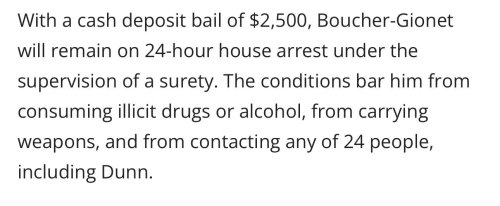-
Posts
7,656 -
Joined
-
Last visited
-
Days Won
84
Content Type
Profiles
Forums
Events
Everything posted by Goddess
-
Carney doesn't give a shite about Canadians. We're nothing but peons, tax cattle. Trudeau was an implementer of throwing metric f*cktons of money at Green investments, Carney is the Godfather of it. All those "investments" are now gone. The battery companies, electric car companies - they took the money and ran. Carney will continue to "invest" in Green shite. But it's going nowhere. He's here because his Green agenda is failing everywhere. GFANZ is being investigated for fraud in the US. Heat pumps? Brookfield profits from it, therefore Carney profits. Modular homes? Brookfield profits, therefore Carney profits. He hasn't given up the WEF dream. He's here to rape us. What amazes me is that you left wingnuts don't see it. "Elbows up for great leader!"
-

Is N. America fated to become a "Second World"?
Goddess replied to Goddess's topic in Federal Politics in Canada
Yet I'm called a racist in this thread on this topic. You're wrong. Nothing has changed. Question immigration numbers or quality and you get called a racist. Even during this last election, conservatives were called racist and anti-immigration because they campaigned on changing it. -

tradewar England Agrees To New Trade Deal
Goddess replied to gatomontes99's topic in Federal Politics in the United States
Thinking our politicians & media endlessly trashing the US & Donald Trump has backfired so hard in their face it’s going to be almost impossible to recover from. Carney running around declaring our relationship is over, we'll find new playmates, elbows up, don’t visit the US and endless vindictiveness towards them will result in us crawling with our tails between our legs begging for forgiveness. No country attacked the US or their President as hard as we did. Id10ts, all of them. -

Is N. America fated to become a "Second World"?
Goddess replied to Goddess's topic in Federal Politics in Canada
No one has anything to say about a 60% increase in disabled immigrants? 5-6% of our population is now disabled immigrants. How long do you think we can keep that up? -

Trump Carney: First Oval Meeting
Goddess replied to August1991's topic in Canada / United States Relations
She wrote a book that was released about a week before the election, describing her meteoric rise to being "First Lady of Canada". That should help. -

Is N. America fated to become a "Second World"?
Goddess replied to Goddess's topic in Federal Politics in Canada
Yes, sorry. I was rushing this morning and it wouldn't post because I had to find the single instance of the word "id10t" to make it post. 🤣 I also truncated the post. I also just ignore Treebeard posts so I didn't see before. Here's the link https://boriquagato.substack.com/p/the-second-world?utm_source=post-email-title&publication_id=323914&post_id=161550153&utm_campaign=email-post-title&isFreemail=true&r=1lx25n&triedRedirect=true&utm_medium=email My apologies. -

Is N. America fated to become a "Second World"?
Goddess replied to Goddess's topic in Federal Politics in Canada
You're definitely not a conservative. I think its described well, above. How a first society functions, how a third world society functions and how a first world society succumbs to its own weaknesses in not defending its way of life, culture and beliefs, thus sliding into being a second world country, which in my opinion, is worse than a third world country. If you're not familiar with Gad Saad's thoughts on "suicidal empathy", perhaps that will explain it more. I agree with Dr. Saad. In the case of the West, I think a large part of it is immigration. Too many, too fast for integration to happen and too many who have no intention to integrate, not that the Canadian govt suggests they do anyways. It doesn't. We're bringing in too many that see Canada as a crime/scam/cheat bonanza. But no one can talk about that or you're a racist. But its not about race. It's about culture & values. That might be part of it. But i dont think its as big a part as what I talk about in the OP. You did remind me of the Monopoly experiment where they give real people unfair advantages to start the game and invariably, they lord it over the disadvantaged players, mocking and denigrating, believing they deserved the advantage because they are better people. It was an interesting video to watch. I don't find your questions genuine, generally, or innocent. If they are in this case, then I apologize. -
But not a word on $60 million ArrivScam or McKenna lost billions or the billions on the SDC scandal that went directly into Liberal pockets or SNC Lavalin or.....it would take hours to name all the taxpayer money thefts. But Libs voted for more of it, so here we go. 🙄
-

Is N. America fated to become a "Second World"?
Goddess replied to Goddess's topic in Federal Politics in Canada
The point of the post wasn't to define 1st world, 2nd world or 3rd world. In fine leftie form, you utterly miss what the point is and want to argue semantics and definitions of words instead. Use whatever definitions you like. -

Is N. America fated to become a "Second World"?
Goddess posted a topic in Federal Politics in Canada
People are familiar with the common construct of “the third world.” They are also familiar with the idea of “the first world.” What’s interesting is the idea of how one becomes the other - thus "the second world". It is not what most people presume - some interstitial state betwixt the third and first worlds, a sort of adolescence one grows through. The difference between the third world and the first world is not actually wealth or development, it’s systems and cultural practices. “The third world” is the base state of humanity, not some aberrant outcome. It’s the norm, a thing that must be escaped by building the structures that allow for human flourishing. When you introduce ideas of scientific rationalism, modern communication and transportation systems, sound property rights, markets (including for capital), and ideas of golden rule, you get a phase change and a meteoric rise to wealth. The fragile idea of "doing unto others as one would have done onto them" in turn that underpins the civilizations capable of supporting sufficient amounts of the free market capitalism that has been the only force to ever lift meaningful numbers of people out of grinding poverty. it’s really the sort of system where you either achieve it or if you don’t, you're locked in a sort of low orbit, low overall development cycle that does not and cannot lift all boats to anything like a first world. It is only by first becoming high trust people that these sorts of structures may find foundation. If a society of low trust people adopts rules designed for high trust societies, it simply fails. None of the systems can function or establish themselves. The second world is not a transitional stage - it's a form of post achievement decline, a once lush garden gone to weeds. The second world is a trap and a truly nasty one from which extrication once caught is very difficult because the second world is, in many ways, the worst of all worlds, it’s first world systems that have fallen into hands and practices under which they cannot function. Low trust people in a low trust system are the third world. If they develop into high trust people, they get the ability to adopt high trust systems and when they do, voila! first world. But if once they have those systems in place, they revert to being low trust people, the second world awaits. I think this is where we are headed. The third world has a number of advantages: Labor tends to be plentiful, cheap. Populations tend to be young. Things like land and construction food and services are inexpensive. There are not a lot of systems or regulation in place. You can “just do things” and it’s easy to build and hire and engage in small scale entrepreneurial activity. The problem is that it’s difficult to scale because the rights and trust systems are not there to support it. The first world also has many advantages: Labor tends to be highly productive and able to use large amounts of capital to be even more so. It comes with lots of rights protection and strong ability to scale because of this and the high trust nature of interactions. It’s safe and predictable. you can have far flung, high function supply and production chains, rich and flourishing. But this enables many things that are in opposition to it - things like widespread welfare, regulatory, and taxation systems. Populations get old. It’s harder to “just do things” and the flourishing increasingly needs advanced technologies, complex chains of interdependence that are great when they run and highly resilient if left alone, but can fail if meddled with sufficiently or if they fall into disrepair or incompetent hands. The rights that make a first world society worth inhabiting become vulnerabilities if consciously abu$ed. The systems of technology that elevate life become boat anchors in the hands of those unable to operate or sustain them. The insidious aspect of the full scope second world is the manner in which it starts to infect and grow within the first world. It’s gradual at first, but accelerates rapidly and you can see it as simple institutions erode and functionality dies. Infrastructure decays and degrades. It starts to feel like you are living in the ruins of a civilization. And once you land here, it's really hard to get out. This is the problem with “the second world”. It’s the worst of all worlds. You have the high cost, high regulation structures of the first world but without the knowhow or labor productivity to support it. In the third world, you’d just “go do things” and fix the grid. Here, the regulatory structures don’t allow it and, because the labor is expensive, no one can afford it anyhow once fortunes start to decline. Life can be pleasant if you have money, but the island is sinking. You can feel the service levels and functionality dropping year by year. You can't escape noticing that this is a system run by folks who cannot seem to manage it and the "deckchairs on the titanic" vibe grows day by day. Some enter the second world by subtraction, but others do so by addition. Power and other utility grids and infrastructure like roads are obvious markers. So are crumbling neighborhoods and neighborhood safety. The ever expanding homeless tent cities and human detritus littering sidewalks and doorways is another second world phenomenon. In the first world, people sh00ting up and passing out in the doorway of your high-end home in a nice neighborhood, get rousted and perhaps arrested by a high functioning police force. In the third world, they get tossed by private security and private actors. Each is a functional system. But in the second world they get treated like precious Faberge eggs, afforded infinite rights and prerogative, ignored by police, and untouchable by homeowners. In the second world, the rights of the anti-social become vectors of societal abu$e. Behavior drops to terrible low equilibriums and the first world rules defend it and first world conflict avoidance makes handling it oneself..... impossible. It has the protections that make sense for sensible, respectful high trust people, but people who are none of those things wind up wielding them like hammers. It can go pretty bad, pretty fast. It has this weird ability to just creep, day by day into normalcy. And no one seems to know how to fix it. That “not knowing” is a sure sign of second world status. The very people you’d think would most want it fixed, wind up being the ones who line up to stop you. There is a basic high trust morality, one where you have a “leave a penny take a penny” system or where places like Costco can have a reputation for “accepting any return for any reason” because they pride themselves on top notch, zero friction customer service. Then some group starts stealing pennies and returning 12 year old stuff as brand new, and the systems choke. People do it on purpose. And it breaks everything. This is why you cannot just drop such low trust, non-golden rule people into high trust, golden rule societies and expect to lift them up. They have no interest in being lifted. They just see easy pickins and go picking. They think you are stupid for letting them and lose respect for you and your ways. After all, why respect a culture full of id10ts who are so easy to take advantage of? It becomes the second world way of life. The second world is a siege, a hostage scenario, a way of life under attack and abuse. The systems are not all crumbling by accident, they are being pulled down by people who prey on it. You can't leave a bike unlocked and go into a store in a place like this and have no fear of theft. You can't have all the easy, pleasant systems of a high trust first world life. And it takes very few to see the rules, game the rules, and break the system, and pretty soon, you stand in the ruins of your civilization while cheap legalism and manipulation exact expensive prices for everyone. In the second world, you get “Stop or I'll say stop again” protestations that bad people find hilarious, because they know they can use your rights structure against you, but you cannot use it in self defense. Bad people can really take good people for a ride. And that which is a nuisance at small scale, rapidly grows until the toxin becomes systemic. All your safety nets get wrapped around your neck and drowns you. This is not seagulls eating french fries left unattended. This is seagulls learning to use the taxpayer’s uber eats account to order from McDonald's to get more fries delivered and no one having any idea how to stop the process and getting called racist and anti-immigrant if they do. In the second world, defrauding the system is the cottage industry. They share plans with one another until the sophistication is incredible. The high trust first world lacks the third world immune system to attack this. Systems stress. Systems break. Systems fail. The second world is the worst of all worlds: Expensive, aged, restrictive, and unable to adapt while being robbed of the productivity and flourishing that made it so attractive. it’s an inversion of ethics through incomprehension and inattention and simpleminded plunder of complex systems that prove too regimented and unpermissive to allow adaptation. It’s a self digging pit until you wake up and realize that not everyone wants what you want, not everyone wants to be like you, and that when you mix third world mores into first world systems, nothing gets raised up. It’s just gravel in gears and sugar in gas tanks. The high trust, high function wealthy west is a small place. Left to itself, it’s incredibly resilient internally and against external threats and stressors. It’s been a flourishing first world experiment in human elevation and progress. But it has little in the way of internal immune system and its systems require high trust to be high function. This is not a way of life to be lightly traded away. -
I swear it's a 12 year old boy behind the avatar. Adult thinking is just beyond its abilities.
-
Exactly. But it WAS the law. And you said you always follow the law. If the law says Kill Jews or Truckers Bad, you fall in line. You do this because you have no principles. No morals. No ethics. Hee Haw I don't live in the past. I learn from it. You should too.
-
Do you? At one time, it was illegal to hide Jews and legal to turn them in. You stand for that, do you? As was said here, you're a spineless invertebrate who has no morals or ethics and repeats whatever the government tells you, like a braying donkey. Hee Haw, Hee Haw you m0r0n.
-
*THIS* is a slap on the wrist 👇 Murder someone, get out on $2500 bail. If Liberals want this for their daughters, that's on them, but most of us normal people do not. Why are Liberals ok with this? You people are insane.
-
-
That wasn't the point. The point was you disagreed that MSM ever lies.
-
Did you forget about this? People got fired over it. CTV says staffers who altered Poilievre clip 'no longer' work for its news team | CBC News
-

Meme/Cartoon of the Day
Goddess replied to WestCanMan's topic in Federal Politics in the United States
They call this guy the Brantford Boomer and he's an internet sensation and the face of this election. He likely bought his house 60 years ago for $12,000 and 8 blueberries and now it's worth almost a million, so he needs this gravy train to keep going. -
This idea you have that criminals have to admit what they did or we can't hold them responsible no matter what the evidence is.....is INSANE. I can see why you love the Liberals.











